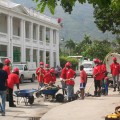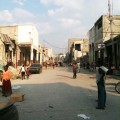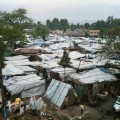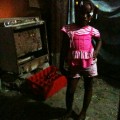(David Rinck reports on recovery and music in Haiti.)
 Port-au-Prince, Haiti — Jan. 12, 2010, was a date that changed literally every person’s life here in Haiti, and still continues to define daily existence for so many people, even as the eyes of the world slowly and inevitably forget and turn to the next disaster area, wherever that may be.
Port-au-Prince, Haiti — Jan. 12, 2010, was a date that changed literally every person’s life here in Haiti, and still continues to define daily existence for so many people, even as the eyes of the world slowly and inevitably forget and turn to the next disaster area, wherever that may be.
 When I turned on the computer at my desk in Nairobi to check the news on that day and read that an epic earthquake had rocked this country (destroying most of the capital Port-au-Prince and killing over 250,000 people), I knew it was only a matter of time before my life changed as well.
When I turned on the computer at my desk in Nairobi to check the news on that day and read that an epic earthquake had rocked this country (destroying most of the capital Port-au-Prince and killing over 250,000 people), I knew it was only a matter of time before my life changed as well.
On March 15, I arrived in Haiti, the poorest country in the Western Hemisphere, after a huge relocation from Nairobi back to San Diego, a change of employers, and a very short flight from sparkling Miami International Airport, knowing very little about this place except for the vignettes of urban poverty and the violence it seems to inspire.
 Oh yeah, and of course I also knew that the country had a history of tragedy when it came to governance. I knew that it all began promisingly enough with the first successful slave rebellion (against colonial France in 1804 in this case), but later degenerated into a series of bloody tyrannies that culminated in the endless rule of the maniacal Duvalier family; Francois “Papa Doc” Duvalier from 1957 until his death in 1971, followed by his son Jean Claude “Baby Doc” Duvalier until 1986, and their notorious machete-wielding Tonton Moucouts militia. Even now, my driver sort of cringes when we pass the enormous hilltop Duvalier family estate on the way up to weekend hiking trips in the mountains above Kenskoff, even though it became property of the Haitian state decades ago.
Oh yeah, and of course I also knew that the country had a history of tragedy when it came to governance. I knew that it all began promisingly enough with the first successful slave rebellion (against colonial France in 1804 in this case), but later degenerated into a series of bloody tyrannies that culminated in the endless rule of the maniacal Duvalier family; Francois “Papa Doc” Duvalier from 1957 until his death in 1971, followed by his son Jean Claude “Baby Doc” Duvalier until 1986, and their notorious machete-wielding Tonton Moucouts militia. Even now, my driver sort of cringes when we pass the enormous hilltop Duvalier family estate on the way up to weekend hiking trips in the mountains above Kenskoff, even though it became property of the Haitian state decades ago.
The more I read, the more I have the impression that something about running this country drives men mad with power. The country’s first real leader Christophe, had himself crowned emperor in 1811 and built an enormous castle (“the citadel,” the country’s most famous, and maybe only, tourist site) in the mountains above Cap Haitian, and even the pastor Jean-Bertrand Aristide who arrived with great fanfare and promise at the presidential palace through a people power-style election in 1990, ran death squads and silenced his detractors in the bloodiest of ways (when he wasn’t in exile because despotic CIA-backed drug dealers had overthrown him and were running the country). Oh yeah, and I also knew something about Voodoo, an African syncretic religion in which people believe that with the help of a Houngan or Voodoo priest, they can become possessed by Gods that speak through them. It defines spirituality for so much of the poor in these countries; I had fleetingly experienced it in Brazil many years ago and later up close in Benin and Togo in West Africa, where it has its origins.
From the air, as my short hour-and-a-half flight from Miami approached the island of Hispaniola, and the lush green of the Bahamas and the Turks and Caicos Islands disappeared under the wing of American Airlines Flight 188, and we neared the Port of Princes, I got my first impressions of another well-known aspect of this steep country: the tremendous environmental degradation for which it is also justly famous.
A desert in the Caribbean seems so unlikely, but there it was below me: the gray, denuded mountainsides that have resulted from years of agricultural poverty scarred by white stripes of erosion, and plains streaked by the ribbons of flash-flood pans. I could also see little specks of color in the urban sprawl that next rolled out under the plane; the thousands and thousands of makeshift tents and plastic sheeting that the international community has provided to the hordes of internally-displaced people (IDPs) that were the reason I was coming here.
A little sweating and hassling for passport stamps and luggage from the various and sundry military at the crowded and confused makeshift warehouse that the U.S. Army had converted into an Arrivals hall just hours after the real one collapsed in the earthquake (can’t believe that went down, echoes of the 1930s U.S. occupation?), and I found myself standing in the absurdly bright Caribbean sunlight on a loud crowded dusty dirt road backed by dilapidated shipping containers serving as airline offices, looking for a driver to take me somewhere. Guitar in hand, and eyes stinging a bit, I had moved to Haiti.
 The northern city of Gonaives in the Artibonite Valley was wiped out by a hurricane in 2008, from which it has yet to recover, and the southeast coast from Belle Anse to Cote de Fer still bears traces of earlier storms. But the damage from the Jan. 12 earthquake is truly beyond belief, nothing else can describe it.
The northern city of Gonaives in the Artibonite Valley was wiped out by a hurricane in 2008, from which it has yet to recover, and the southeast coast from Belle Anse to Cote de Fer still bears traces of earlier storms. But the damage from the Jan. 12 earthquake is truly beyond belief, nothing else can describe it.
 As a land of economic migrants from impoverished rural areas built over steep mountains, few places are as vulnerable as greater Port-au-Prince and the surrounding towns like Carrefour and Leogane, to a disaster like earthquakes. Literally everywhere, in a huge radius from the epicenter in Gressiers, is marked by collapsed buildings, twisted steel rebar, ruined homes and trashed streets. Every imaginable public space, from the central Champs de Mars plaza in front of the destroyed presidential palace to the schoolyards and narrow dividers on the main road up to the affluent neighborhood of Petionville where I live, and even quite of few of the already congested and narrow streets, are choked with people camped out either because they lost everything or out of fear of the next quake, which has already been predicted. Even the plush Petionville Golf Club has been turned into a makeshift IDP camp (admirably run by Sean Penn). And with agriculture in ruins from years of neglect to economic development, and seven major tropical storms and hurricanes predicted this season as well, most of then have no way to sustain themselves if they return to the rural areas they came from. Walls everywhere are sprayed with graffiti asking for help – “we need doctors, water, food, etc.” (Later, an even sadder theme was added to this, as Haitians remembered their lost husbands, children, friends etc, and massages like “Adieu Rene”; “I’ll never forget you, Jacqueline”; “goodbye mom and dad” and so on appeared on the walls of ruined homes across the city.)
As a land of economic migrants from impoverished rural areas built over steep mountains, few places are as vulnerable as greater Port-au-Prince and the surrounding towns like Carrefour and Leogane, to a disaster like earthquakes. Literally everywhere, in a huge radius from the epicenter in Gressiers, is marked by collapsed buildings, twisted steel rebar, ruined homes and trashed streets. Every imaginable public space, from the central Champs de Mars plaza in front of the destroyed presidential palace to the schoolyards and narrow dividers on the main road up to the affluent neighborhood of Petionville where I live, and even quite of few of the already congested and narrow streets, are choked with people camped out either because they lost everything or out of fear of the next quake, which has already been predicted. Even the plush Petionville Golf Club has been turned into a makeshift IDP camp (admirably run by Sean Penn). And with agriculture in ruins from years of neglect to economic development, and seven major tropical storms and hurricanes predicted this season as well, most of then have no way to sustain themselves if they return to the rural areas they came from. Walls everywhere are sprayed with graffiti asking for help – “we need doctors, water, food, etc.” (Later, an even sadder theme was added to this, as Haitians remembered their lost husbands, children, friends etc, and massages like “Adieu Rene”; “I’ll never forget you, Jacqueline”; “goodbye mom and dad” and so on appeared on the walls of ruined homes across the city.)
To top it all off, another grim aspect of life here is the violent crime and gang activity that makes this one of the most dangerous and difficult places I’ve ever worked. Over 5,000 of the country’s most dangerous criminals escaped when the quake collapsed the central prison in Port-au-Prince, and the United Nations Stabilization Mission in Haiti (MINUSTAH) has been damned slow in rounding them up again (though they seem to be able to find the parties and the beaches fairly readily). Kidnappings for ransom, often rumored to be with the complicity of the Haitian National Police; carjackings; and random shootsouts are daily occurrences here, and it’s pretty normal to hear the crackle of gunfire in the city as I sit under curfew in my compound and Skype with friends at night. Even this morning as I’m writing this, I listened to someone shooting at something or someone down near the Rue de Delmas below the office. It’s often joked that Haiti is the only country in the world not at war that has a U.N. peacekeeping force. Hahaha, what a crackup. … Taste the fury.
 Now in my third month here, though, I’m also beginning to discover the source of another less well-known but even more defining aspect to this country. That is, its deep cultural and especially musical traditions. While nowhere near as commonly recognized as other nearby musical wellsprings like Jamaica and Trinidad, Haiti fully keeps pace with its Antillean neighbors when it comes to music.
Now in my third month here, though, I’m also beginning to discover the source of another less well-known but even more defining aspect to this country. That is, its deep cultural and especially musical traditions. While nowhere near as commonly recognized as other nearby musical wellsprings like Jamaica and Trinidad, Haiti fully keeps pace with its Antillean neighbors when it comes to music.
Haiti, arguably more than any other country in the West Indies, is the direct recipient of the distinctive rhythm that is the backbone of the blues tradition in the Southern United States, and that was very specifically carried from the Gulf of Benin by the armies of slaves that came to work plantations in these places. Just as Jamaicans took these beats, and blended them with the R&B they heard on American AM radio and turned into it all into Ska, Rock Steady, Dancehall, and eventually Reggae, Haitians have fused this beat with Latin Salsa and Meringue, to come up with Compa, the local popular style, which can be heard in thousands of nightclubs around the country on any given night of the week. Memories of nights in the sleazy bars in Tijuana with the Wallflowers, those were different times, but same sweaty dingy décor, same music of the people pumping out.
But in the countryside, the paysans also sing and play musique racine in the fields and rural homes with a more folk feel, drawing more on Voodoo for rhythms and lyrical themes. In urban areas, this has circled back to produce the most genuine Haitian underground musical experience – Voodoo Rock. This genre is most famously played by the band Racine Accion Musique (or RAM as they are popularly known here). And the quintessential musical experience in Port-au-Prince is to catch them live on Thursdays when they make their regular late night appearance at the Oloffson Hotel, a sprawling antique period-piece lodging built in the classic gingerbread style of the Antilles, made famous by Graham Greene in his Haiti-set novel “The Comedians” and owned by RAM’s lead guitarist, an eccentric Dominican-American named Richard Morse. I’m urging him to make a visit to the Che Underground site.
So while we’re still waiting for a Ry Cooder to come and put it on the map with a Haitian Buena Vista Social Club CD, knowledgeable musicians have been braving the dangers and making pilgrimages to the country for decades. Mick Jagger has a suite named after him at the Oloffson Hotel, and Iggy Pop once shot an album cover here (Zombie Birdhouse) during a long martini- and voodoo-soaked sojourn to the Port of Princes and to the cultural capital Jacmel in the early ‘80s. (Haiti has long been a destination for the decadent, since its very lax laws on control of prescription drugs makes a morphine or Seconal martini a realistic and practical option for happy hour at many of the capital’s best bars.) In any case, the average Haitian carries a ton of musical tradition on his shoulders, which is worth seeking out. Check out the cat in the attached video that I shot in an IDP camp I visited on the day after my arrival here. Truly, Blues Haitien.
Great stuff indeed. No wonder that one of the great classics (in my opinion) on this country is titled “Haiti — Best Nightmare on Earth,” a magic surrealist chronicle in the well-established tradition of Haitian opposition anthropology. Add to all this a warm, thoughtful and spontaneous music-loving people who speak a delightful, expressive and unique language, Haitian Creole, and who eat hearty spicy food, invariably accompanied by the staple rice and beans that we Californians need to survive as well, and a lot of the negative of this place is hugely offset. As a result, I’m also starting to share that one final trait for which this country is also so justly famous: Despite Haiti’s many challenges, its visitors almost invariably ending up falling in love with it and wanting never to leave. … Anyone wanna come for a visit?
— David Rinck
More from Dave Wallflower: